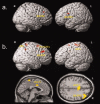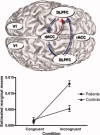Fronto-cingulate effective connectivity in obsessive compulsive disorder: a study with fMRI and dynamic causal modeling
- PMID: 20162605
- PMCID: PMC6871164
- DOI: 10.1002/hbm.20980
Fronto-cingulate effective connectivity in obsessive compulsive disorder: a study with fMRI and dynamic causal modeling
Abstract
Evidence suggests that obsessive compulsive disorder (OCD) is associated with an overactive error control system. A key role in error detection and control has been ascribed to the fronto-cingulate system. However, the exact functional interplay between the single components of this network in OCD is largely unknown. Therefore, the present study combined a univariate data analysis and effective connectivity analysis using dynamic causal modeling (DCM) to examine error control in 21 patients with OCD and 21 matched healthy controls. All subjects performed an adapted version of the Stroop color-word task while undergoing fMRI scans. Enhanced activation in the fronto-cingulate system could be detected in OCD patients during the incongruent task condition. Additionally, task-related modulation of effective connectivity from the dorsal ACC to left DLPFC was significantly stronger in OCD patients. These findings are consistent with an overactive error control system in OCD subserving suppression of prepotent responses during decision-making.
Copyright © 2010 Wiley-Liss, Inc.
Figures





References
-
- Annett M ( 1967): The binomial distribution of right, mixed and left handedness. Q J Exp Psychol 19: 327–333. - PubMed
-
- Banich MT, Milham MP, Jacobson BL, Webb A, Wszalek T, Cohen NJ, Kramer AF ( 2001): Attentional selection and the processing of task‐irrelevant information: Insights from fMRI examinations of the Stroop task. Prog Brain Res 134: 459–470. - PubMed
-
- Blasi G, Goldberg TE, Weickert T, Das S, Kohn P, Zoltick B, Bertolino A, Callicott JH, Weinberger DR, Mattay VS ( 2006): Brain regions underlying response inhibition and interference monitoring and suppression. Eur J Neurosci 23: 1658–1664. - PubMed
-
- Botvinick MM, Cohen JD, Carter CS ( 2004): Conflict monitoring and anterior cingulate cortex: An update. Trends Cogn Sci 8: 539–546. - PubMed
-
- Buchel C, Friston KJ ( 1997): Modulation of connectivity in visual pathways by attention: Cortical interactions evaluated with structural equation modelling and fMRI. Cereb Cortex 7: 768–778. - PubMed
Publication types
MeSH terms
LinkOut - more resources
Full Text Sources
Medical

